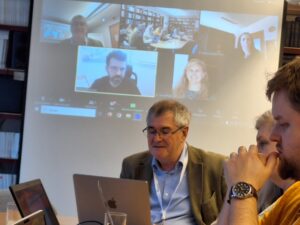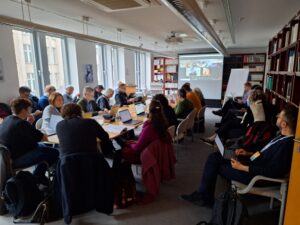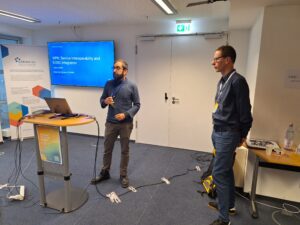The ATRIUM Kick-off Meeting meeting started with a brief overview given by Megan Black (Project Manager) and Toma Tasovac (Project Coordinator) of DARIAH. Toma outlined how ATRIUM is focussed on demonstrators and workflows along with capacity building and upskilling of people working in the Digital Humanities. In addition, ATRIUM has to align itself with several other initiatives which include the OSCARS Project (SSHOC members), the EOSC, Common European Data Spaces (Europeana) and the Collaborative Cloud for Cultural Heritage (leading to the ECHOES Project starting mid-2024). It was also noted that ATRIUM is offering 388 weeks of Transnational Access.
This was followed by an overview of the project activities, starting with Megan (DARIAH) outlining the administrative requirements for the project. Then, Franco Niccolucci (ARIADNE RI) took the stand to talk about the dissemination and communication for the Project. This also includes an Impact Evaluation which will be undertaken by Guntram Geser (ARIADNE RI). Unusually, there is no initial communication and dissemination plan but as the participating RIs all have well established channels with experienced people, this activity will mainly require co-ordination between the key parties. One of the first tasks for DARIAH is to set up the ATRIUM website and communication channels (social media, mailing lists etc.).
Moving onto to the technical work, Achille Felicetti (ARIADNE RI) is leading the work on Facilitating Discovery of and Access to Humanities Resources. This involves looking at all the various schemas, ontologies and vocabularies used in the Humanities and establishing a shared meta-vocabulary. As well, harmonising and improving metadata and establishing a feedback loop between repositories and aggregators will be a key aim. Standards are also key for making data more easily used and processed by other applications and the Use of OCR and IIIF is important for this task. Finally, multi-linguality is essential for improving discoverability of resources and the LINDAT translation web service run by CU will make a major contribution to achieving this aim.

Julian Richards chairing the WP4 & WP5 break-out meeting
Next, Julian Richards (ARIADNE RI) described two closely linked tasks, these being the development of enhanced workflows along with demonstrators. These are based on archaeological data types text (documents and reports), images, 3D, sound (audio recordings) and geo-spatial data. The ARIADNE portal will be used to provide a front-end to many of the demonstrators. On day 2, when the different tasks went into break-out groups, with a couple of people also participating via Zoom, it was this work that generated the most in-depth discussion and lasted the longest time due to the breadth and depth of activities involved. For example, both Czech and English language documents will be provided as texts, some being handwritten, others typed or printed (or digital). Images may use IIIF – the DARIAH Media Hub takes images as input and outputs IIIF-compatible data. Example use cases will be based on an ADS archive of high-quality photos of early medieval sculpture, and Rock Art from ADS and SND (images collected from the public);graffiti may also a possibility.
Another aspect discussed was automatic image recognition – the demonstrator should be able to make use of the metadata already in the ARIADNE

Participants in the WP4 and WP5 joint break-out meeting
Portal for these, especially if it is enhanced for this purpose. Recognition of objects contained within images may be possible, but the project doesn’t have the resources to retrain a complete image recognition model. The 3D aspects focussed upon Web-based visualisation tools where two different approaches may be used: 3DHOP-based visualisation and HBIM. The challenge here will be to align and integrate the two tools with the AO-CAT etc. HBIM is being adopted by organisations such as CYI and LNEC to record and monitor built heritage and may include environmental information as well, combining micro and macro scale information. HBIM data from the HS2 archaeological surveys in the UK (held at ADS) will be used to test out integration with GIS data as well.
The discussion on sound data identified existing tools for converting audio into text which may then be further processed, for metadata extraction for example. Sound files of interest are commentaries with drone recordings and possibly video recordings. The last topic was geospatial data and working with maps and geotagging. The potential for archaeology includes maps for excavations, archaeological sites and tying in ancient place names / gazetteers to sites. Visualisation is an important aspect, especially for the ARIADNE Portal. Finally, the concept of multi-disciplinary spatial data tagging was discussed in depth as there are many aspects to be considered such as the level, spatial resolution, data types etc.

Marco Raciti of DARIAH and Dieter Van Uytvanck of CLARIN
For “service Interoperability and EOSC Integration”, the tasks here aim to make all the ATRIUM services interoperable and integrate the workflows with these. CLARIN will be leading this work as it also involves some of their existing applications such as the Switchboard. Furthermore, these services (possibly community platforms and portals) will be connected to EOSC at some level. There are two more specific tasks within the scope of this work package, these being:
- to connect repositories from the ATRIUM portfolio of services with the Diamond Open Access scientific publishing platform episciences.org by using standardised protocols and formats (OAI-PMH) in order to facilitate the dissemination of diverse research outputs via overlay journals hosted on the platform.
- To evolve the automatic speech recognition (ASR) portal into a component of a research environment suited for use by oral history researchers working with spoken data into a prime example of deep integration with EOSC services.
The last part of the work involved in ATRIUM concerns the development and delivery of training for digital humanities researchers. One part is making a skills requirements assessment through surveys, desk research, interviews and currently available data from previous projects in order to develop a curriculum to support cross-disciplinary research – this is being led by OPERAS. An additional output will be the ATRIUM Peer Review Framework for open peer review assessment of different research outputs (data publications, training materials, software, exhibitions, interactive visualisations, etc.) as a contribution toward maximising the quality and impact of Arts and Humanities research and which will encourage Humanities researched to follow the principles of Open Science. The DARIAH overlay journal will be used as a case study. Finally, the other part is the provision of Transnational Access which is being offered by several ATRIUM partners, as in-house visits and/or as summer schools. The first call for applications is scheduled for March so those involved are going to be very busy preparing everything, especially ADS who will be managing the whole offering.

